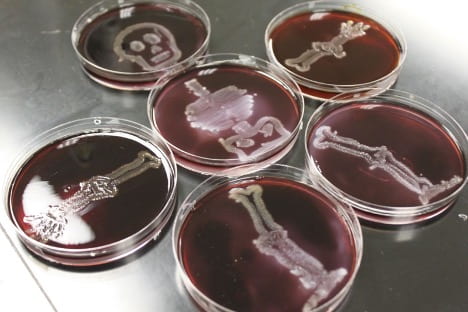
COURTESY OF KANDY LOPEZ Agar art on starch-iodine plates, created by NSU student Breanna Jones in 2020.
Trillions of bacterial cells live both inside and on the surface of the human body and are essential for bodily functions. Recently, bacteria are also being harnessed in another field: the arts.
Julie Torruellas Garcia, microbiologist and professor in the Department of Biological Sciences, described agar art as using different strains of bacteria to create colorful artworks on agar, or bacteria food.
“Agar art is creating artwork using bacteria as your paint and Petri dishes with agar as your canvas,” she said. “Typically, people prefer to use bacteria that have pigmentation of different colors, Serratia marcescens [is] red, or Micrococcus luteus has that golden yellow color. We [always] use safe bacteria that are not going to cause disease to humans, even some that are naturally found on or in the human body.”
Agar art is a component of Art Lab (ARTS 3030), an art class created and taught by Kandy Lopez, associate professor and program director of Art + Design in the Department of Communication, Media, and the Arts. Lopez said Art Lab aims to connect the fields of art and science.
“I think all students need to be able to see themselves and their future within their major. That includes the arts and the sciences. And since we’re under the same umbrella for our college, and I’ve worked with various doctors and science disciplines, it only made sense to create a course that will benefit all of us,” she said.
Kayle Mederos, junior biology major, experienced making agar art in an Intro to Drawing class and is currently taking Art Lab.
“I thought it was interesting how different bacteria interacted with different agar colors, [and] as a biology major, it felt like a class that was right for me, as a combination of art and science,” she said.
For her upcoming Art Lab assignment, Mederos hopes to illustrate the life cycle of a bacteriophage, a type of virus that infects bacteria, within her Petri dish canvases.
In 2023, for the first time, artwork created by NSU students over the past eight years were compiled into an exhibition dedicated to agar art, which was displayed in the Alvin Sherman Library, Research, and Information Technology Center.
Garcia said the exhibition had been a long time in the making,
“Since 2017, Kandy and I have been collaborating on agar art. [We] had published a research article in the journal for Microbiology and Biology Education. People from the American Society for Microbiology offered us funding to do the agar art exhibition, [as] they wanted local agar art exhibits. Every year, we [also] enter the ASM annual agar art contest,” she said.
Lopez believes it’s crucial for artists and scientists to exist in the same space.
“A lot of time, artists need the quantitative side, and scientists need the qualitative side, so they feed off of each other. It’s easier to solve problems when there are different thinkers in the room,” she said.
Art and science students looking to try agar art or learn the techniques associated with plating bacteria can consider taking Art Lab even year winters or Microbiology (BIOL 3400) every fall and winter.

Be the first to comment on "Agar art: Common ground for art and science students"